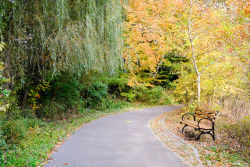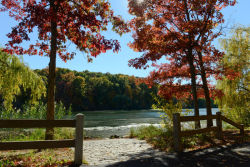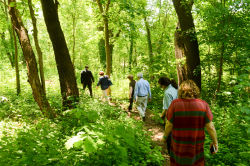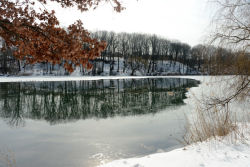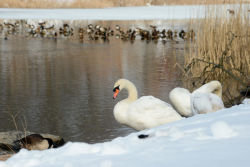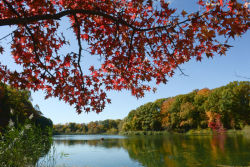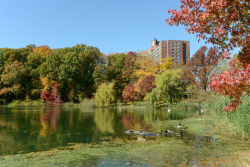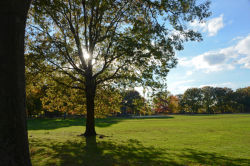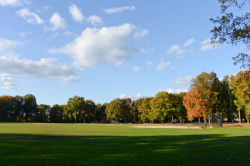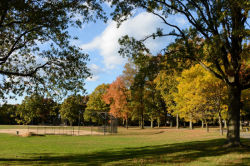Alley Pond Park
Alley Pond Park
What was here before?
The park lies on a glacier-formed moraine, a ridge of sand and rock that formed 15,000 years ago at the southern terminus of the Minnesota Ice Sheet. The glacier dropped the boulders that sit on the hillsides of the southern end of the park and left buried chunks of ice that melted and formed the ponds dispersed throughout the valley. Geologists call these “Kettle Ponds.” Freshwater drains into the valley from the hills and bubbles up from natural springs, mixing with the saltwater from Little Neck Bay. As a result, the park is host to freshwater and saltwater wetlands, tidal flats, meadows, and forests, creating a diverse ecosystem and supporting abundant bird life.
The native Matinecock once inhabited the area around Alley Pond Park, attracted by the shellfish in Little Neck Bay. In 1673, King Charles I of England (1600-1649) gave a 600-acre land grant to Thomas Foster, who built a stone cottage close to modern-day Northern Boulevard. Soon others built mills that harnessed water flowing into Alley Creek. Although the area supported some light industry, it stayed essentially rural through the end of the 19th century. William Vanderbilt’s (1849–1920) privately run Long Island Motor Parkway was built through the area in 1908, a harbinger of the age of automobile travel that would shape the park through the 20th century.
How did this site become a park?
The population of Queens doubled in the 1920s and the City of New York moved to protect open spaces by acquiring the site on June 24, 1929. NYC Parks acquired 330 acres of land surrounding the alley later that year, the most significant acquisition in the creation of the park.
The newly constructed 26-acre park, officially opened in 1935 and included a 23-acre bird sanctuary, tennis courts, 200-space parking lot and the Alley Pond Park Nature Trail, the first trail in the city’s park system. Title to the Vanderbilt roadway was transferred to NYC Parks in 1937 and the next year it was converted into a 2.5-mile bicycle path.
In its zeal to convert the area for recreational uses and through the construction of the Long Island Expressway and Cross Island Parkway in the 1930s, the parks department filled in much of the marshland. This area was later recognized as a vital link in the ecosystem. In 1974, NYC Parks created the Wetlands Reclamation Project and began rehabilitating the natural wetlands.
In 2007, the park became home to New York City’s first public high ropes adventure course, part of NYC Parks’ Urban Park Rangers’ larger Alley Pond Park Adventure program. A low–cost outdoor education and adventure program, Alley Pond Park Adventure teaches participants how to canoe, use a compass, fish, and enjoy a natural setting without leaving New York City.
Who is this park named for?
The site is named for The Alley, an 18th-century commercial and manufacturing center formerly located here. The origin of that center’s name is the subject of some debate. One theory is that “alley” refers to the shape of the glacier-made valley. Another holds that colonial travelers, who passed through the valley to Brooklyn, en route to the Manhattan ferries, named it “the alley.” The well-traveled passage is believed to have been the route George Washington (1732-1799) took while touring Long Island in 1790.
Check out your park's Vital Signs
Clean & Safe
Green & Resilient
Empowered & Engaged Users
Share your feedback or learn more about how this park is part of a
Vital Park System

